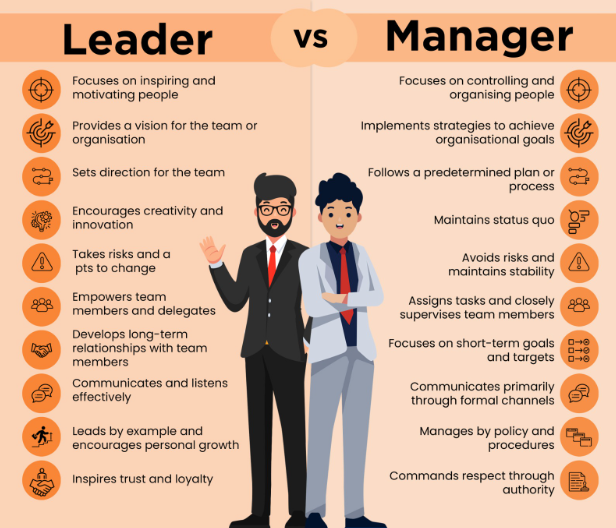Table of Contents
Leader vs Manager: Who Inspires & Who Directs?
Have you ever wondered about the difference between a leader and a manager? While both roles are important in any organisation, they require different skill sets and approaches to achieve success. In this blog, we’ll explore the differences between leaders and managers and why it’s important to understand the distinction in a work environment.
Leader
“A good leader takes a little more than his share of the blame, a little less than his share of the credit.” – Arnold H. Glasow
A leader is someone who can influence, motivate, and inspire others to work towards achieving a common goal or vision. Leaders can come from any level or position within an organisation and lead formal or informal groups.
Leadership is not tied to a specific role or title but is a set of skills and traits that enable individuals to guide and direct others towards success.
Understanding Leadership
Leadership motivates and guides others to achieve a common goal or vision. It involves establishing a clear direction, setting goals, communicating effectively, and inspiring others to take action. Effective leadership requires strong interpersonal skills, strategic thinking, and the ability to make tough decisions.
For further understanding of leadership, click here
Qualities that a Leader should possess
Leaders possess various qualities that enable them to guide and inspire others effectively. Some of the key attributes of a leader include:
- Visionary: A leader has a clear vision of where they want to go and what they want to achieve and can communicate that vision to others.
- Strategic Thinker: A leader can analyse complex situations, identify opportunities, and develop plans to achieve goals.
- Communicator: Leaders can communicate their vision and goals effectively and motivate and inspire others through their words and actions.
- Integrity: A leader is honest, transparent, and has a strong sense of ethics and values.
- Empathy: A leader can understand and connect with the emotions and perspectives of others and can build strong relationships based on trust and respect.
- Resilience: A leader can adapt to change, bounce back from setbacks, and maintain a positive attitude.
- Decisiveness: A leader can make tough decisions, even when uncertain or risky.
- Delegation: A leader can delegate tasks and responsibilities effectively and empower and develop others to reach their full potential.
Manager
“The best managers are those who have an intimate knowledge of their employees’ strengths, weaknesses, and aspirations.” – Peter Drucker
A manager is responsible for planning, organising, coordinating, and controlling resources (such as people, finances, materials, and equipment) to achieve specific goals or objectives. Managers may hold formal titles and positions, such as CEO, director, supervisor, or informal leaders who guide and direct teams.


What is Management?
Management is the process of planning, organising, coordinating, and controlling resources to achieve specific goals or objectives. Effective management requires prioritising tasks, making decisions, delegating responsibilities, communicating effectively, and motivating and developing employees.
Qualities that a Manager should possess
Top Managers possess various qualities that enable them to effectively manage resources and achieve their goals. A successful manager’s key qualities include the following:
- Strategic Thinking: A manager can analyse complex situations, identify opportunities and threats, and develop strategies to achieve goals.
- Decision-making: A manager can make tough decisions, even when faced with uncertainty or risk, and balance competing priorities and trade-offs.
- Communication: A manager can communicate effectively with employees, stakeholders, and customers, listen actively, and provide feedback.
- Time Management: A manager can prioritise tasks, manage their time effectively, and meet deadlines.
- Delegation: A manager can delegate tasks and responsibilities effectively and empower and develop employees to reach their full potential.
- Technical expertise: A manager has a strong understanding of the technical aspects of their industry and can apply that knowledge to manage resources effectively.
- People skills: A manager can work effectively with people and build strong relationships based on trust and respect.
- Adaptability: A manager can adapt to change, be flexible, and adjust their approach as needed to achieve their goals.
Difference Between a Leader and a Manager
“Management is doing things right; leadership is doing the right things.” – Peter Drucker
The terms “manager” and “leader” are often used interchangeably, but they represent two different types of people in an organisation. While both positions are vital to a company’s success, there are significant differences between the two roles.
Let’s explore the differences between managers and leaders and examine the qualities that make someone successful in each role.
1. Vision and Strategy
Leaders focus on developing and communicating a compelling vision for the organisation’s future. They set the direction, define the goals, and create a roadmap for the team. In contrast, managers focus on implementing strategies to achieve the organisational goals set by the leaders. They ensure the team is aligned with the vision, implement policies, procedures, and processes to ensure efficiency and consistency and monitor progress towards the goals.
2. Communication and Relationship Building
Leaders prioritise effective communication and building long-term relationships with their team members. They listen to feedback, provide guidance and support, and inspire trust and loyalty. Leaders encourage open and honest communication and foster a culture of transparency and collaboration.
Managers, on the other hand, primarily communicate through formal channels and focus on task-oriented communication. They assign tasks, provide feedback, and measure performance.
3. Creativity and Innovation
Leaders encourage creativity and innovation by empowering team members to take risks and experiment with new ideas. They create a culture that values innovation, celebrates successes, and learns from failures. In contrast, managers focus on maintaining the status quo and avoiding risks. They follow established policies and procedures and are more concerned with minimising errors and ensuring consistency.
4. Delegation and Empowerment
Leaders delegate tasks and responsibilities to their team members, empowering them to make decisions and take ownership of their work. They trust and encourage their team members to develop their skills and knowledge. In contrast, managers tend to micromanage their team members, closely supervise their work, and assign tasks based on their skills and expertise.
5. Short-Term vs Long-Term Focus
Leaders tend to have a long-term focus, while managers focus on short-term goals and targets. Leaders consider the bigger picture and the organisation’s future direction, while managers are more concerned with meeting deadlines, achieving targets, and ensuring operations run smoothly.
What are some ways to measure the success of management practices?
Measuring effective management can be challenging, as it involves assessing factors such as employee engagement, productivity, and overall organisational performance. However, several ways to measure effective management include
Employee Engagement Surveys
Conducting regular surveys to measure employee engagement levels can provide insight into how well managers are leading their teams. These surveys can gather information about employee satisfaction, motivation, communication, feedback, and collaboration.
Performance Metrics
Measuring performance metrics such as sales revenue, customer satisfaction, project completion rates, and employee turnover rates can provide a quantitative measure of effective management. These metrics can show how well managers meet organisational goals and how their management practices impact overall performance.
360-Degree Feedback
360-degree feedback involves gathering feedback about a manager’s performance from various sources, including peers, subordinates, and superiors. This feedback can provide insight into how well managers communicate, delegate, provide feedback, and develop their team members.
Observation and Coaching
Observing managers in action and giving feedback and coaching can help identify areas where they can improve their management skills. This approach can involve on-the-job training, mentoring, and coaching to help managers develop their skills and improve their effectiveness.
Employee Retention
Measuring employee retention rates can provide insight into how well managers create a positive work environment and develop their team members. Low employee retention rates indicate that employees are unsatisfied with their work or are not receiving the support and development they need.


What are some ways to measure the success of Leadership practices?
Measuring effective leadership is important to evaluate the impact of a leader’s actions and behaviours on the organisation and its people. Here are some ways to measure effective leadership:
360-Degree Feedback
Gathering feedback from a leader’s peers, subordinates, and superiors can provide valuable insights into their leadership style, strengths, and areas for improvement. This feedback can be gathered through surveys or interviews to assess a leader’s communication, decision-making, problem-solving, and people management skills.
Employee Engagement
Leaders who effectively engage their employees will see higher employee satisfaction, motivation, and productivity levels. Regular employee engagement surveys can provide insight into how well leaders connect with their teams and create a positive work environment.
Organisational Performance
Effective leaders should drive the organisation towards achieving its goals and objectives. Measuring key performance indicators such as revenue, profit margins, customer satisfaction, and employee turnover rates can quantitatively measure a leader’s impact on the organisation.
Personal Development
Effective leaders continuously strive to improve their skills and knowledge. Measuring a leader’s personal development through training programs, certifications, and workshops can indicate their commitment to self-improvement and ability to lead by example.
Succession Planning
Effective leaders should have a succession plan in place to ensure that the organisation can continue to thrive even if the leader were to leave. Measuring a leader’s success in developing future leaders and creating a culture of continuous learning and development can indicate their effectiveness as a leader.
In Conclusion,
Both leaders and managers play important roles in an organisation but require different skill sets and approaches to achieve success. Leaders focus on creating a vision, setting direction, and inspiring and motivating others to achieve common goals. In contrast, managers focus on planning, organising, coordinating, and controlling resources to ensure the efficient execution of strategies.
Let’s take the example of a startup company. The managers in the startup are responsible for overseeing day-to-day operations, ensuring that resources are allocated efficiently and that projects are completed on time and within budget. However, with a strong leader providing a clear vision for the company’s future, the startup can find footing in a crowded market.
That’s where leadership comes in. A strong leader can provide a clear direction for the company, inspire employees to innovate and take risks, and make strategic decisions that position the company for long-term success. By combining management’s focus on efficiency with leadership’s focus on vision and innovation, the startup can build a strong foundation for growth and success.
Understanding the differences between these two roles is important for organisations to create a culture that values leadership and management. To ensure that both functions work together to achieve the organisation’s goals.



